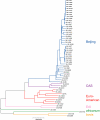Microevolution of extensively drug-resistant tuberculosis in Russia
- PMID: 22294518
- PMCID: PMC3317155
- DOI: 10.1101/gr.128678.111
Microevolution of extensively drug-resistant tuberculosis in Russia
Abstract
Extensively drug-resistant (XDR) tuberculosis (TB), which is resistant to both first- and second-line antibiotics, is an escalating problem, particularly in the Russian Federation. Molecular fingerprinting of 2348 Mycobacterium tuberculosis isolates collected in Samara Oblast, Russia, revealed that 72% belonged to the Beijing lineage, a genotype associated with enhanced acquisition of drug resistance and increased virulence. Whole-genome sequencing of 34 Samaran isolates, plus 25 isolates representing global M. tuberculosis complex diversity, revealed that Beijing isolates originating in Eastern Europe formed a monophyletic group. Homoplasic polymorphisms within this clade were almost invariably associated with antibiotic resistance, indicating that the evolution of this population is primarily driven by drug therapy. Resistance genotypes showed a strong correlation with drug susceptibility phenotypes. A novel homoplasic mutation in rpoC, found only in isolates carrying a common rpoB rifampicin-resistance mutation, may play a role in fitness compensation. Most multidrug-resistant (MDR) isolates also had mutations in the promoter of a virulence gene, eis, which increase its expression and confer kanamycin resistance. Kanamycin therapy may thus select for mutants with increased virulence, helping preserve bacterial fitness and promoting transmission of drug-resistant TB strains. The East European clade was dominated by two MDR clusters, each disseminated across Samara. Polymorphisms conferring fluoroquinolone resistance were independently acquired multiple times within each cluster, indicating that XDR TB is currently not widely transmitted.
Figures




References
-
- Banerjee A, Dubnau E, Quemard A, Balasubramanian V, Um K, Wilson T, Collins D, de Lisle G, Jacobs W 1994. inhA, a gene encoding a target for isoniazid and ethionamide in Mycobacterium tuberculosis. Science 263: 227–230 - PubMed
-
- Borrell S, Gagneux S 2009. Infectiousness, reproductive fitness and evolution of drug-resistant Mycobacterium tuberculosis. Int J Tuberc Lung Dis 13: 1456–1466 - PubMed
-
- Brown TJ, Nikolayevskyy VN, Drobniewski FA 2009. Typing Mycobacterium tuberculosis using variable number tandem repeat analysis. Methods Mol Biol 465: 371–394 - PubMed
